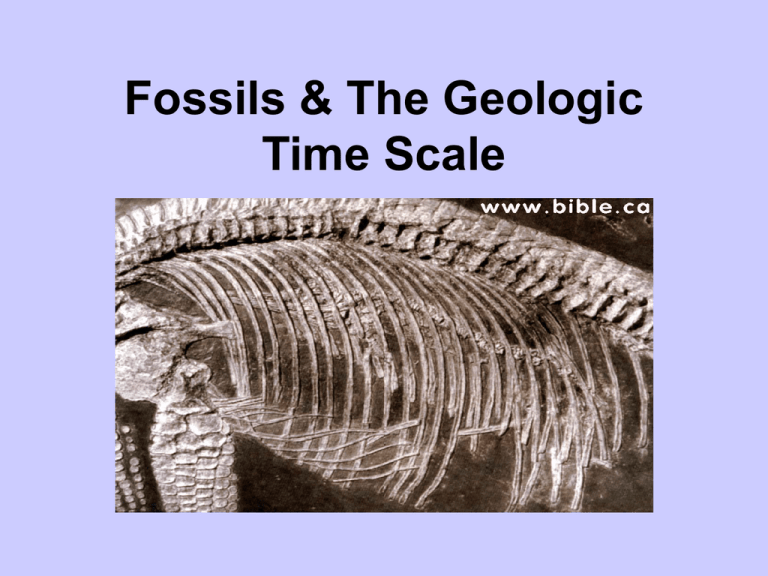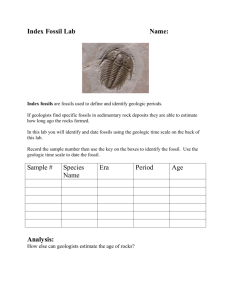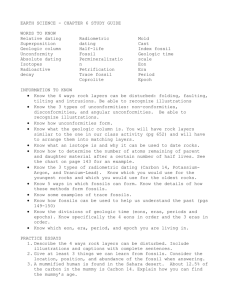Fossils & The Geologic Time Scale
advertisement

Fossils & The Geologic Time Scale Anticipation Guide • If you agree with the statement, put an √ beside it. If you disagree with the statement, put an X beside it. • ____ 1. Fossils show how plants and animals have changed over time. • _____2. It is rare for the soft parts of an organism to become a fossil. ____ 3. A footprint is an example of a trace fossil. • ____ 4. A petrified fossil is an animal that was scared just before it died. Fossils • Preserved remains or traces of an organism that lived in the past. •Fossils are formed when organisms die and are buried in sediment. Eventually the sediment builds up and hardens to become sedimentary rock. •Sediments are pieces of solid material that have been deposited on Earth’s surface by wind, ice, gravity, or chemical precipitation. •Paleontologist-scientist who study the remains of organisms in the rock record. Kinds of fossils • Petrified - when minerals replace the remains and they become rock things like wood. • Mold - when the shell remains and the contents dissolve (hollow) like in art class you use a mold to get the correct shape of a bowl. • Cast - when the mold becomes filled with minerals that are not a part of the original organism. • Index- a fossil found in a narrow time range but widely distributed around the earth;used to date rock layers. • Trace fossil-a fossilized mark that is formed in soft sediment by the movement or actions of an animal. PETRIFIED CAST MOLD • Sometimes whole animals become preserved intact, but this is very rare. If an organism is surrounded by ice or tar they might be discovered looking much the same as they did when they died. AETOSAUR FOUND IN THE NATIONAL PETRIFIED FOREST Relative Dating Relative dating: looks at where the fossil is located to determine its age relative to other fossils. This only works if the area has been undisturbed. Absolute Dating • Uses radioactive elements near the fossils to determine the actual age of the fossils. •By determining the age of the radioactive element, scientists can calculate the age of the fossil buried nearby. The absolute age of fossils is estimated by dating associated igneous rock and lava flows. Fossil Record • The dating of all fossils is included in the Geological Time Scale. This scale divides the time that the earth has existed into 4 eras. • Eras are then divided into periods based on common events in that time period. Anticipation Guide If you agree with the statement, put an √ beside it. If you Anticipation Guide disagree with the statement, put an X beside it. ____ 1. An epoch is larger than a period. ____ 2. Periods are the largest division of geologic time. ____ 3. The smallest period of geologic time is the era. ____ 4. Fossils and rock layers on different continents are similar. Vocabulary • Copy the definitions below in your notebook on your definitions page. 1. geologic time scale – a model scientists use to describe the timing of events and the relationships between those events in earth’s history. 2. era – one of three long periods of geologic time from Precambrian to the present. 3. period – geologic time periods that eras are divided into. 4. epoch – a division of geologic time; a subdivision of a period. PreCambrian • Began with the formation of the Earth 4.6 billion years ago. • Bacteria appeared 3.5 billion years ago, followed by algae and fungi. Paleozoic Era • Divided into 5 periods: • Cambrian period Sponges, snails, clams and worms evolve • Ordovician period First fishes evolved and other species become extinct • Silurian period - Land plants, insects and spiders appear • Devonian period Amphibians evolve and cone-bearing plants start to appear. • Carboniferous period Tropical forests appear and reptiles evolve. • Permian period - Seed plants become common and insects and reptiles become widespread. Sea animals and some amphibians begin to disappear. Mesozoic Era • Divided into 3 periods: • Triassic period - Turtles and crocodiles evolve and dinosaurs appear. • Jurassic period - Large dinosaurs roam the world. First mammals and birds appear. • Cretaceous period Flowering plants appear, mammals become more common, dinosaurs • become extinct. Cenozoic Era • Divided into 2 periods: • Tertiary period - First primates appear and flowering plants become the most common. • Quaternary period Humans evolve and large mammals like woolly mammoths become extinct. ASSIGNMENT •Read back through the notes you have just taken. Design 4 multiple choice questions about the content. • •Design one question which asks for a description or explanation with details.






